Welcome to Card Game DB
Register now to gain access to all of our features. Once registered and logged in, you will be able to create topics, post replies to existing threads, give reputation to your fellow members, get your own private messenger, post status updates, manage your profile and so much more. If you already have an account, login here - otherwise create an account for free today!
Register now to gain access to all of our features. Once registered and logged in, you will be able to create topics, post replies to existing threads, give reputation to your fellow members, get your own private messenger, post status updates, manage your profile and so much more. If you already have an account, login here - otherwise create an account for free today!
Crafting the Theory - Deck Archetypes
Aug 07 2013 05:05 AM |
WWDrakey
in Game of Thrones
Small Council Crafting the Theory WWDrakey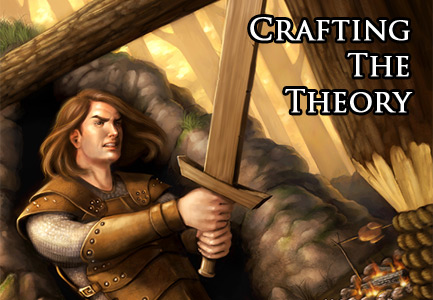 A while back, we had some heated conversations on the CardgameDB Forums on the merits and differences of the four primary playstyles in AGoT - Aggro, Rush, Control and Combo. Looking back, one worrisome aspect were the differing opinions on what actually constitutes a particular playstyle. As long as AGoT players are not on the same page with regard to the terminology, it can be quite hard to develop any real theoretical understanding of the game to a higher level.
A while back, we had some heated conversations on the CardgameDB Forums on the merits and differences of the four primary playstyles in AGoT - Aggro, Rush, Control and Combo. Looking back, one worrisome aspect were the differing opinions on what actually constitutes a particular playstyle. As long as AGoT players are not on the same page with regard to the terminology, it can be quite hard to develop any real theoretical understanding of the game to a higher level.Thankfully, such definitions are exactly the kind of stuff that we here at Crafting the Theory thrive on. So, without further ado, it’s time to get into the nuts and bolts of what makes each playstyle work.
Deck Archetype vs. Playstyle
Getting right into the business of defining vocabulary, there’s a very important first step we need to make. What is it we should really call Aggro, Control, Rush and Combo? Are they Deck Archetypes, or Playstyles? Is it the deck that dictates the way the game rolls, or is it really the driver behind the wheel?
Now, the important first clue here comes from the fact that the deck you’re playing can completely stop you from playing it in a specific way. How exactly do you Control with a Baratheon Noble Rush deck? Which cards in a Targaryen KotHH can you actually be used for Rushing? What kind of Combo could you pull off with a classic TLV deck?
Basically the player is free to play a deck with their own Playstyle... but only within the spread of approaches that a given deck allows them. Because of this, we are choosing to talk here about Deck Archetypes, even though the two terms are often quite interchangeable and intimately connected. The playstyle of a player dictates the way they construct a deck, and the structure of the deck hints to the player how it should be played.
There is also another reason why we’re opting for this approach - measurability. Player decisions in-game are hard to measure, so when looking for definitions for the archetypes, we need to look at what the game is all about - cards. Always the cards.
Aggro
Overall
So what actually constitutes an Aggro deck? How do you identify one?
With the Spring 2013 Meta having been dominated by The Long Voyage (TPoL) -fuelled Aggro decks this one should be much easier to answer now than before. A general description for Aggro would be that it always aggressively aims for board position supremacy, while interrupting your opponent's play through high claim challenges and using challenge-victory -based effects for additional removal to drill in the advantage.
Winning challenges to apply pressure to your opponent on all fronts is key when playing with Aggro, and this also applies to stopping your opponent from pushing his or her challenges through. Generally, individual cards are mostly dispensable, since the overall position is the primary target you are aiming for. Aggro is mainly a playstyle focusing on the mid-game.
The Cards
Plots - Plots in an Aggro deck tend towards the two things needed for overall board dominance - high-claim and good resources. Effects on the plots tend towards ones that either give you a leg up in winning challenges or help maximize the impact from the pressure you are applying. The easiest way to figure out if a deck is Aggro is to look at the plot deck, and count the number of high-claim plots there.
Example - The most classic Aggro plot is The Power of Arms (Core), with it’s combination of 2-claim, STR boosts and decent gold production.
Reset - Aggro decks are quite varied with regard to Resets - from sometimes running without one (expecting to rely on their huge board presence) to running Valar Morghulis (Core) themselves (to combat other Aggro decks). Whatever the choice, one thing is always clear. They are themselves the most important reason that other decktypes must run resets...
Characters - What Aggro looks for in a character is a good cost-to-strength ratio, keywords that help win challenges, crests for triggering events and abilities that help a character participate in several Challenges in one round. Pure numerical efficiency is the order of the day, and every card needs to be available for helping push those all-important challenge-wins through. Effects on characters tend to favor those that trigger off winning challenges.
Example - Northern Cavalry Flank (SA) quite nicely epitomizes a good Aggro card. 5 STR for 4 gold, deadly for helping push challenges through, an ability that conditionally stops it from kneeling for challenges.
Amount - Due to the requirement of a large board presence and being so intimately tied to winning challenges, Aggro-decks tend to be the decktype with the most characters. For a pure 60-card Aggro-deck 35 characters is probably quite close to the minimum, and something as high as 40-45 characters is not completely unheard of.
Locations - When it comes to locations, Aggro tends to vary between an average and high number. The emphasis is both on locations that will allow them to push through challenges and retain board dominance. There is also a slight trend towards limited-use locations, as long as they are extremely cost-effective. With regard to the cost of lactions, the overall emphasis tends to be on cheaper locations, since those help the decks optimize their setups better.
Examples - A perfect example of a good limited-use Aggro-location would be The Iron Cliffs (HtS), with the way it helps retain board dominance. Meanwhile Frozen Outpost (LoW) would be a good example of a more permanent location. Most 0-cost non-Limited reducers like Street of Steel (Core) are also very common in Aggro decks.
Amounts - On average, Aggro decks usually run around 15 locations for a 60-card deck, but this can vary between decktypes.
Events - Two primary categories - those that help win challenges and those that trigger off winning them.
Examples - The Price of War (KotS), No Quarter (TBC) and Die by the Sword (LoW) are all iconic Aggro cards.
Amount - The number of events is usually quite low, but they often have a very high impact on the board position.
Attachments - Attachments are usually more of an afterthought in Aggro-decks, and sometimes (like in classic Baratheon Knight -decks) completely omitted. When running attachments, they tend to be more negative, and focus on either taking characters out of challenges, making them more vulnerable or closing out their abilities.
Examples - Fishing Net (ASoS), Milk of the Poppy (Core).
Amount - Low.
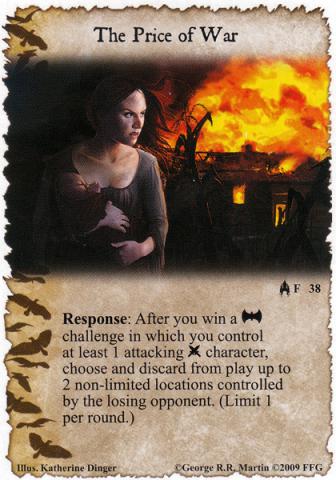
Control
Overall
Control has an impressive historical record in AGoT, having held a strong position in the Meta for most of the LCG. But what are the elements that make it Control, and how do you discern whether all your characters got killed by Controlling, and not through Aggro?
The key element in understanding Control are effects, because that’s what Control lives and dies on. Every card needs to do something, and not just stand there being beefy. Only by having more effects than your opponent can you successfully dictate the direction of the game, and make sure that your opponent’s hands are successfully tied. Usually the emphasis here is also on effects which have flexible timing, and while Aggro lives and dies with winning Challenges, Control will always try to do it's work outside of them. Because of this, effects triggering off you actually winning challenges tend to be quite unfavorable for Control.
Strong individual card effects are a hallmark of control, as are playing with a small and flexible board position, interrupting challenge math through card effects and stalling for advantage. Without other themes mixed in Control is a clear end-game deck, which instead of working against the clock, has all the time in the world... as long as it can thwart the opponent from winning quickly. This long-term emphasis is also seen in the way Control decks are always looking for long term card advantage (be it draw or recursion).
At this point it is important to note that Control is actually comprised of two, quite dissimilar, approaches - Hard Control (mainly Burn) and Soft Control (such as Icon Manipulation or Kneel). While Hard Control aims at using card effects to permanently remove cards (or at least characters) from your opponent, Soft Control simply settles for making your opponent unable to actually do anything with the cards they have. The important difference between the two is one of impact. Hard Control tends to have high-cost and high-impact effects, while Soft Control relies more on cheaper repeatable effects.
The distinction with price is very important here. If Hard Control were able to have effects at the same prices as Soft Control, it would inevitably dominate, due to the more permanent nature of the solutions involved. There’s also a third sub-type of Control deck called a Toolbox, which is mostly found in decks running The Maester's Path (GotC). This decktype usually runs a mixture of Soft and Hard Control with narrower applications, then proceeds to choose the Control tools it uses according to the opponent it is facing.
The Cards
Plots - Every Plot in a Control deck must do something. Usually this means cards with especially When revealed -effects or strong constant effects that tie into controlling your opponent. Claim and resources are merely an afterthought.
Examples - City of Sin (AToT) (and the whole City Cycle of Plots), Threat from the North (PotS) as well as Shadows and Spiders (LotR).
Resets - Reset early, reset often is the order of the day. Control decks can often get very good mileage of dragging the game out by running multiple resets. Valar Morghulis (Core) is usually not optional.
Characters - Control tends to favor characters with powerful effects, especially ones triggered by the character coming into or leaving play. In a way, characters tend to be looked at as more events (but ones with legs), ones that provide you a 2-for-1 advantage in both helping you control the board with their effects and additionally give you some board presence. Repeatable control effects on characters are also worth their weight in gold, as well as passive effects that stop your opponent from doing specific things. Statistics, keywords, icons and crests on a character are merely a nice bonus. It’s what they actually do that counts.
Differences - Characters are one of the places where Soft and Hard Control also differ quite a bit, since Soft Control decks usually run at least one ‘finisher card’ (think The Red Viper (PotS) or Southron Mercenaries (TBoBB) in Martell or Tyrion Lannister (CoS) in Lannister Shadows) in order to close the game out when they have a lock on it. Hard Control rarely has the luxury of paying the cost of a finisher, and is in less of a hurry to close the game out.
Examples - Castellan of the Rock (BoRF), Enemy Informer (Core), King's Landing Assassin (SaS), Orphan of the Greenblood (PotS), Watchful Servant (CD), Varys (SaS) and Ser Arys Oakheart (PotS).
Amount - Control decks tend to be the decks with the least number of characters. In 60-card decks this usually means something between 20-30, but can also be higher or lower, depending on the structure of the deck.
Locations - Control decks love their locations, be they additional long-term resources or repeatable strong-effects.
Examples - Aegon's Hill (TTotH), Meereen Tourney Grounds (ODG), The Scourge (ODG), Lannisport Brothel (Core), The Black Cells (TftRK)
Amount - Control decks tend to have more locations than most, often going close to 20 for a 60-card deck. However, this is not a given and less location-heavy Control-builds also exist.
Events - Events are really the heart of Control. The more you have, the better you can affect the flow of the game. Hard Control tends to go for more costly events with permanent removal, while soft control relies more on well-timed effects that negate your opponent’s challenges.
Examples - The Hatchlings' Feast (ASitD), Westeros Bleeds (Core), You've Killed the Wrong Dwarf! (Core), A House Divided (WLL), Burning on the Sand (RotO)
Amount - Most Control-decks are very event-heavy, making Knights of the Hollow Hill (MotM) a tempting Agenda choice.
Attachments - With characters merely being events on legs, it’s not really worth it to play any positive attachments on them. However, negative attachments do often play quite an important role in Control decks as well as attachments which function as repeatable Control in any manner.
Examples - Flame-Kissed (Core), Venomous Blade (TBoBB), Milk of the Poppy (Core) and Flogged and Chained (TftRK)
Amount - Some, number depends on the type of Control being employed.
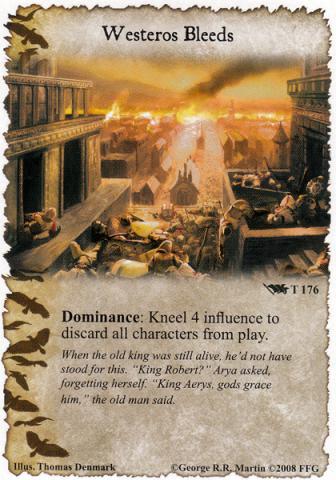
Rush
Overall
Rush is often (mistakenly) thought of as a type of Aggro, possibly because of a large portion of the most prominent “Rush†decks actually being hybrids of Aggro and Rush, with pure Rush decks being a much rarer sight to behold. So, if Rush is not a type of Aggro, what is it? And how can you tell Rush and Aggro apart?
The key to understanding Rush lies in understanding the simple principle of ‘power first, everything else second’. And that everything-part there, it contains board dominance just as much as it does toolbox solutions to problem cards or control of the challenge phase. See, when given a choice between more power, hurting your opponent or maintaining a strong board-presence... Rush will always choose power. Which really makes it the clearest early game decktype. The game only has one win condition after all, and that’s what Rush will always work for. Another interesting quirk with Rush it that it will also often take a beating from it’s opponent just to generate more power on their House... power that it will try to grab when given the chance. Losing ground isn’t an issue, as long as it takes you closer to the finish line.
Once you start really looking at the two decktypes, you start seeing how they move in completely opposite directions. While Aggro is the deck to exert the most pressure on it’s opponents board, Rush is probably the one to exert the least. Where Aggro is clearly Destructive and wants to beat it's opponent down, Rush is Constructive and only wants to play it's own game. The only pressure it exerts is the psychological feeling of being under a very fast ticking clock. The game will always be decided in a very finite number of moves - there are no take-backs or room for error. If anything, pure Rush is probably closer to some Combo decks as it is to Aggro.
One way of looking at Rush is to say that it’s the most gutsy of playstyles. There’s nothing like the feeling of first having made all the correct choices for two rounds and then top-decking on Turn 3 and hoping against hope to draw into that one card that can help you close out the game... before the black jaws of sure defeat close around your throat. Another way of looking at Rush is to say that it’s the playstyle most dependent on both your deck and... luck. The parts will either click into place properly, or they won’t... and it’s completely possible that your opponent will have a slow start and not stand much of a chance.
The Cards
Plots - The plots for Rush-decks usually fill one of two functions, they either increase your power-gain or protect your board for enough time for you to win the game. Good resources are needed for the early plots, while claim is pretty much inconsequential.
Examples - The Power of Blood (Core) and The Art of Seduction (LotR) are quintessential protection plots, while The Red Wedding (PotS) and Winter Festival (WotN) are some of the most often run power-gain plots.
Reset - Because of it’s early game focus Rush can just as well run with and without a Reset depending on the amount of saves it has available. It’s not like you will ever have to play it if your deck clicks together...
Characters - The heart of Rush decks are really the power-gain characters - be it with renown or power-gain abilities triggering off challenge wins. Interestingly enough, these are usually not as efficient with regard to board presence as Aggro characters, since you will often find yourself paying 4 to 5 gold for 3 STR with very little keywords that actually help win challenges. This is offset by the fact that most of your cheper characters will either be ones with keywords that allow you to push through challenges, or ones with utilitarian effects.
Examples - The Red Viper (PotS), Rhaegal (QoD), Robert Baratheon (Core), Beric Dondarrion (IG) and Archmaester Ebrose (CbtC) are all classic power-gainers, while both Bastard of Robert (Core) and Maester Cressen (Core) would be good examples of the type of supportive weenies that Rush favors.
Amount - Rush decks tend toward quite standard numbers of characters, with a much higher number of duplicates than usual. An average estimate would be slightly over 30 characters for a 60-card deck.
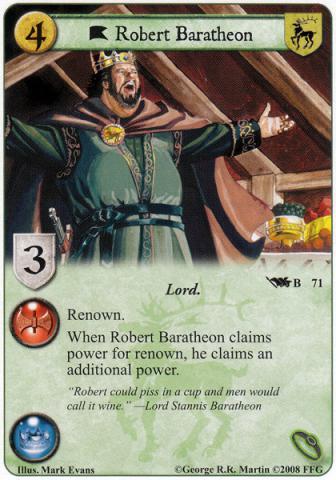
Locations - Rush decks tend to run a surprisingly low number of locations, with most of them committed to quick resource acceleration. Non-resource locations that make the cut are those which either help push through challenges, provide power-gain or help provide more mileage out of your power-gain characters.
Examples - Seat of Power (WotN), Smuggler's Cove (KotStorm), Scouting Vessel (KotS) and Yunkai (QoD).
Amount - Low, somewhere between 10-15 for a 60-card deck, with resources aimed at the early game.
Events - Rush decks tend to go for one-shot events that either directly or indirectly (standing, extra-challenges) help with power-gain and winning challenges. Due to their vulnerability to control, they also sometime run cancel-events.
Examples - Superior Claim (KotStorm), Distinct Mastery (Core), War of Five Kings (RoW) and Paper Shield (QoD)
Amount - Due to their early-game focus Rush decks tend to run quite a decent amount of events.
Attachments - Rush decks are the rare decktype that tends to go for positive attachments over negative ones, especially ones that help protect the power-gain characters or make them gain more power.
Examples - Bodyguard (Core), Lightbringer (Core), Support of Harlaw (KotS), Flaming Sword (DB) and Aegon's Blade (Core) are all positive attachments that tend to find a place in Rush decks.
Amount - Rush decks tend to run a decent number of positive attachments, since they are already relying quite a bit on keeping the power-gain characters alive.
Combo
Overall
In the LCG Era Combo has possibly been even more rare as Deck Archetype than Rush in any kind of pure form - at least in the competitive scene. So what really is a pure combo-deck? And how’s that different from all of the other decks that tend to have a decent amount synergy built-in?
Now, there’s one important criteria for a Combo-deck. Your deck must contain a combination of cards, which when combined correctly, will automatically grant you the win - unless their interaction is somehow interrupted. Further, this interaction usually should not depend on obtaining challenge victories, although this is not always strictly true. And this is further complicated by the fact that Combo-decks can pretty much be divided into Powergain and Lockdown decks, with the two types differing in many regards.
Sounds complicated, so what does it all really mean? Well, let’s look at a few examples of a combo deck. Since combo-decks have rarely been competitive in AGoT, the builds we are looking at will naturally be stuff that usually only sees casual play. Our first example would be House Tully and Riverrun (LoW). Play Riverrun and any number of House Tully characters. Now, after those cards are in play, it’s up to your opponent to stop you from reaching 15 power with your combo. Riverrun is really a classic example of a Combo-engine for a Powergain-type Combo-deck. What all Powergain engines have in common is the ability to provide repeatable or massive power-gain - usually without winning a single challenge.
Now, while Powergain-combo decks are usually seen mostly as cute, Lockdown decks are a completely different beast altogether. What they aim at is nothing less than completely stopping your opponent from being able to play the game anymore - the ultimate NPE (Negative Play Experience) if you will. A good example of a Lockdown Combo-deck actually made it quite high in the Regionals Season this year. It was a Baratheon Maester-deck run by a former World Champion, which aimed at completely discarding the opponent’s deck within the first few Turns. Now, this deck does not create a win-condition, but rather victory only happens after the opponent’s choices and cards are reduced to near nothing. Other similar Combo-decks may aim at decimating the opponent’s hand before Round 1, stopping them from ever drawing (or getting to use) any additional cards. Which leads us over to that most iconic of all decks aiming for a Lockdown Combo - Greyjoy Choke, which attempts to completely choke out your opponent's resources.
The thing about Combo-decks has usually been, that if they ever become truly competitive or consistent, that is usually followed by a huge outcry and eventual breaking of the Combo via errata and restrictions. However, as we can see from Greyjoy Choke, there are exceptions.
The Cards
The cards for Combo-decks tend to vary quite largely depending on the Combo in question. Nevertheless there are some patterns and cardtypes that should be mentioned here.
Plots - Unless the Combo in question is formed by Plots (there used to be one with Bran Stark (Core) and Support of Saltcliffe (GotC) for example), then the Plot deck mainly serves two functions - stalling the game unless you find your pieces or searching for the pieces.
Examples - Building Season (Core), Loyalty Money Can Buy (QoD), Across the Summer Sea (APS) in Melee,
Winter Festival (WotN) for Powergain Combos that try to Cycle through your Plot deck.
Reset - Combo-decks often tend to run a Reset, so that they can either stall until they find their Powergain engine, or cleanup after they obtain Lockdown on your opponent’s draw.
Characters - There are a lot of Characters that function as some kind of Powergain Combo-engine. Outside of them, this category will fluctuate quite widely depending on the Combo in question. Characters that help thin the deck down or search for cards are often good choices for Combo decks.
Examples - The Queen of Thorns (TftRK), Tywin Lannister (LotR), The Brazen Beasts (ARotD), Viserys Targaryen (KotS) and Salladhor Saan (EB) are all Powergain-engines, while Balerion the Black (RotO) would be an example of a Lockdown-engine. House Messenger (PotS) and Red Warlock (ASoS) would be standard thinner/search characters. The Sparr (APS) and Ice Fisherman (TWoW) in Choke.
Amount - Depends entirely on the Combo itself.
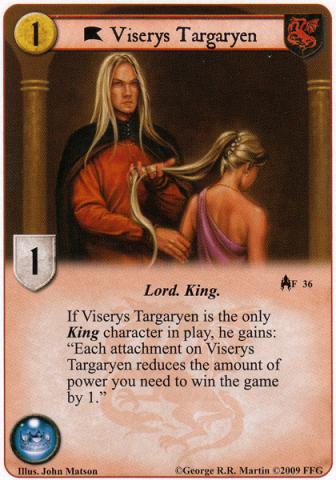
Locations - Just like characters there are quite many Locations that can function as Powergain engines. Outside of them locations tend to be for resource production or stalling the game.
Examples - The Iron Throne (ASitD), Riverrun (LoW) and Corpse Lake (TBC) would be examples of Powergain engines, while King Robert's Hammer (TBoBB) and Massey's Hook (ASoSilence) were both alternative stand-engines for the Lockdown Combo used with Baratheon Maesters. River Blockade (RoR) for Choke decks.
Amount - Usually a decent amount, but depends on the Combo.
Events - Events are often employed for tutoring (searching for) combo pieces, although there are also a few that actually function as engines themselves.
Examples - Much and More (AHM) and Desperate Measures (TCC) would be good cards for digging for your combo, while Bran the Builder's Legacy (Core) is a classic search card and both A Nest of Vipers (TftH) and Sitting the Iron Throne (AToTT) are Powergain-engines for specific combo-decks.
Amount - Again, the number varies according to the Combo.
Attachments - There are only a few attachment-based engines in AGoT, so these usually tend to function as pieces that allow combination of otherwise uncompatitable cards with each other.
Examples - Support of Saltcliffe (GotC), Rhaegar's Harp (BoRF) and Gutter Rat's Cunning (Core) (for Massey's Hook (ASoSilence)) are all cards that can be used to tie combo-pieces together. Brass Link (HtS) was the heart of the Lockdown Combo used with Baratheon Maesters. Burned and Pillaged (FtC) for Greyjoy Choke.
Amount - Once more the same song - depends on the Combo.
Conclusion and Hybrids
A Game of Thrones LCG is a hugely varied game, with a wide spectrum of different types of decks. And while there are decks that fit perfectly into one of these four archetypes, for each of those. there exist several that don’t clearly fit any of them. Some decks may only employ Control elements to make way for their power rush cards, while others combine them with an impressive board position and high claim.
So what’s the point of having these four core archetypes, if they don’t cover the whole variety of decks? While many decks may not embody a single deck archetype, almost any deck can be expressed as a hybrid, or combination, of the four basic archetypes. In this way, these four archetypes function as a foundation for any deck imaginable.
Disagree with the definitions presented here? Want to chime in with how your favorite decktype fits into these archetypes... or breaks them altogether? Let us know in the comments below!
- mischraum, Kennon, zordren and 24 others like this



 Sign In
Sign In Create Account
Create Account











12 Comments
I highly suggest a follow up article analysing the houses (as well as neutral) and how their individual card pools fall under the particular archetypes.
Also, for any new players reading this article, remember: each house's kit will drastically change how they play an archetype. While they will use some similar cards (plots mostly), the house specific kit will change how a deck plays. A Targ Dragon rush will play differently than a Bara noble rush. They have a lot of similarities, but they also have a lot of differences even though they are both rush decks. A Stark aggro will play differently than a Greyjoy Aggro, Ect. So keep that in mind.
I just have one question. Why do you consider choke a combo deck?
I consider it control. I can see both points of view though. I guess if it gets its pieces out its extremely hard to beat which leads to the NPE. But I don't feel like a choke deck (maybe its just mine which is a maester choke) needs exact pieces to win. Yeah there is a few cards I really like to see in my hand than others but I don't need x, y, and z to be present to be win the game. I feel like control decks feel the same way. A control deck has pieces it loves to see but doesn't need x, y, and z to win either.
At the gates (combo?)
A time for ravens (combo?)
Forgotten plans (control?)
Twist of fate (aggro?)
Rise of the kraken (aggro?)
Valar (control?)
Rule by decree (control?)
Maybe my version of choke isn't typical and its more of a hybrid then which is what is skewing my view of the archetype.
Why? I like to take this view, since the deck basically aims at executing a complete Lockdown Combo, but even when it's not able to completely execute it, it's stopping it's opponents from using many of their cards (like a Soft Control deck). So, while the Combo is clearly the ultimate goal, the deck doesn't fall apart due to the Control-side.
However, I still think Choke warrants a mention as a Lockdown deck, since it's one of the few often competitively seen Lockdown builds, and thus helps people identify and understand the functionality from practical experience.
This would really be helpful!